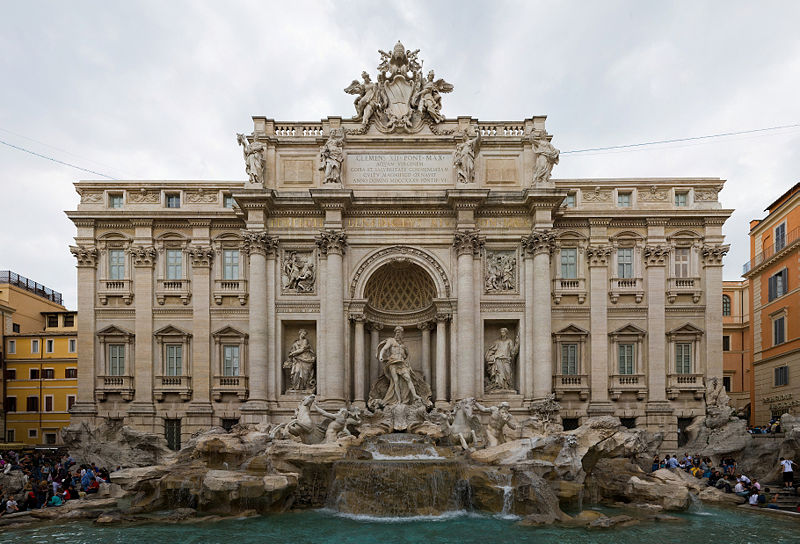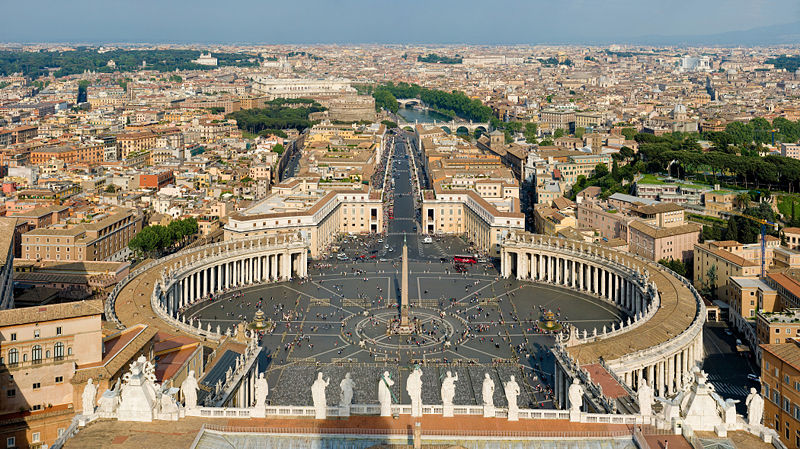Places to visit
There are many places to visit in Rome. A few specific ones are the Trevi Fountain, Pantheon, Colosseum, Spanish Steps, and St. Peter's. This page will give brief details on each of these locations and their history.
 At the end of an aqueduct constructed in 19BC (Aqua Virgo)
in 1732- Pope Clement XII told Nicola Salvi to create a large fountain at the Trevi Square
supposed to be built earlier, but didn't go through with plans because of Pope Urban VIII's death
Salvi based fountain on the original design
completed in 1762
Neptune, god of the sea, is the central figure. He is riding in a shell-shaped chariot pulled by two seahorses
Each seahorse is guided by a Triton. One is obedient and the other is restive. They symbolize the moods of the sea.
Left hand side of Neptune- statue represents abundance
right- statue represents salubrity (Conducive or favorable to health or well-being.)
above sculptures are bas-reliefs- one is Agrippa (the girl who the aqueduct was named after)
water at the bottom of the fountain represents the sea
legend has it that if you throw a coin into the water over your shoulder with your back to the fountain..you will return to Rome
At the end of an aqueduct constructed in 19BC (Aqua Virgo)
in 1732- Pope Clement XII told Nicola Salvi to create a large fountain at the Trevi Square
supposed to be built earlier, but didn't go through with plans because of Pope Urban VIII's death
Salvi based fountain on the original design
completed in 1762
Neptune, god of the sea, is the central figure. He is riding in a shell-shaped chariot pulled by two seahorses
Each seahorse is guided by a Triton. One is obedient and the other is restive. They symbolize the moods of the sea.
Left hand side of Neptune- statue represents abundance
right- statue represents salubrity (Conducive or favorable to health or well-being.)
above sculptures are bas-reliefs- one is Agrippa (the girl who the aqueduct was named after)
water at the bottom of the fountain represents the sea
legend has it that if you throw a coin into the water over your shoulder with your back to the fountain..you will return to Rome
 built more than 1800 years ago
The dome is more than 43 meters high
It was the largest dome in the world until 1436 when the Florence Cathedral was constructed
There is an opening at the top of the dome, the oculus, which was the only source of light
The front portico has three rows of 8 columns, each one with a diameter of 1.5 meters.
A huge bronze door gives access to the cylindrical building.
This church was originally a temple built for all pagan gods. It was converted into a church in 609.
Contains the tombs of Raphael and of several Italian Kings
Interior design contrast with the temple's structural design, but the marble floor still features the original Roman design
borders the Piazza della Rotonda, a rectangular square with a central fountain. It is situated in the historic center of Rome.
built more than 1800 years ago
The dome is more than 43 meters high
It was the largest dome in the world until 1436 when the Florence Cathedral was constructed
There is an opening at the top of the dome, the oculus, which was the only source of light
The front portico has three rows of 8 columns, each one with a diameter of 1.5 meters.
A huge bronze door gives access to the cylindrical building.
This church was originally a temple built for all pagan gods. It was converted into a church in 609.
Contains the tombs of Raphael and of several Italian Kings
Interior design contrast with the temple's structural design, but the marble floor still features the original Roman design
borders the Piazza della Rotonda, a rectangular square with a central fountain. It is situated in the historic center of Rome.

 Colosseum Facts
Colosseum Facts
- Emperor Vespasian started construction in AD 72
- completed in AD 80- 1 year after Vespasian's death
- orignally known as Flavian ampitheatre
- 188m by 156m and height of more than 48m (159 feet)
- would accommodate 55,000 spectators- no less than 80 entrances
- above ground are 4 storeys
- upper storey- seating for lower classes and women
- lowest storey- for prominent citizens
- below ground were rooms and cages containing wild animals and mechanical devices. Cages could be hoisted, enabling animals to appear in the middle of the arena
- covered with enormous awning known as the valarium to protect spectators from the sun. 1,000 men were used to install it. Attached to large poles and anchored to ground by large ropes.
- Emperors used Colosseum to entertain public with free games. The games were a symbol of prestige and power
- helped Emperor to increase popularity
- games held for a day to several days in a row
- usually started with comical acts and displays of exotic animals
- ended with fights to the death between animals and gladiators or between gladiators
- gladiators were usually slaves, prisoners of war, or condemned criminals
- sometimes free Romans or even emperors took part in action
- 100-day games held by Titus, Vespian's successor, to mark inauguration of the building in AD 80. Around 9,000 animals were slaughtered in the process
- Southern side of Colosseum felled by earthquake in 847
- Parts were used for construction of later monuments including St. Peter's Basilica
 One of the most popular meeting places in Rome
Connects a French church on top of the hill to the Spanish Square
The idea of connecting the church with the square below originates from the 17th century, when the French also planned a statue of King Louis XIV of France at the top of the staircase
Papal opposition caused the plans to be shelved until 1723, when the monumental staircase was built without the statue.
Pope Innocent XIII appointed the Italian architect Francisco de Sanctis. He presented a design that satisfied both the French and the papacy.
Consists of 137 steps over twelve different flights. It has an irregular albeit symmetric structure.
It is decorated with azaleas in May
attracts tourists and locals and is usually very crowded
One of the most popular meeting places in Rome
Connects a French church on top of the hill to the Spanish Square
The idea of connecting the church with the square below originates from the 17th century, when the French also planned a statue of King Louis XIV of France at the top of the staircase
Papal opposition caused the plans to be shelved until 1723, when the monumental staircase was built without the statue.
Pope Innocent XIII appointed the Italian architect Francisco de Sanctis. He presented a design that satisfied both the French and the papacy.
Consists of 137 steps over twelve different flights. It has an irregular albeit symmetric structure.
It is decorated with azaleas in May
attracts tourists and locals and is usually very crowded
 Emperor Constantine demanded a basilica on Vatican Hill. He was the first Christian emperor. The location was symbolic because it was where Saint Peter was buried in AD 64. A small shrine existed. It was replaced by a new church that was completed around AD 349.
In the 15th century, the basilica was falling into ruin. Pope Nicolas V ordered restoration and enlargement of church with plans by Bernardo Rossellino. Works were halted after Nicolas V's death
In 1506, Pope Julius II laid the first stone of new basilica
Julius II appointed Donato Bramante as chief architect of the new Basilica. Michelangelo succeeded Donato Bramante in 1547.
It was completed in 1626 and dedicated by Pope Urban VIII that year.
Church has drawn pilgrims and been the center of Christianity ever since.
Largest church in the world
Interior includes 45 altars decorated by many famous artists
Pieta- Michelangelo
Papal Altar- Bernini
Monument of the Stuarts- Conova
Emperor Constantine demanded a basilica on Vatican Hill. He was the first Christian emperor. The location was symbolic because it was where Saint Peter was buried in AD 64. A small shrine existed. It was replaced by a new church that was completed around AD 349.
In the 15th century, the basilica was falling into ruin. Pope Nicolas V ordered restoration and enlargement of church with plans by Bernardo Rossellino. Works were halted after Nicolas V's death
In 1506, Pope Julius II laid the first stone of new basilica
Julius II appointed Donato Bramante as chief architect of the new Basilica. Michelangelo succeeded Donato Bramante in 1547.
It was completed in 1626 and dedicated by Pope Urban VIII that year.
Church has drawn pilgrims and been the center of Christianity ever since.
Largest church in the world
Interior includes 45 altars decorated by many famous artists
Pieta- Michelangelo
Papal Altar- Bernini
Monument of the Stuarts- Conova
Back to Main
Roman Gods
When in Rome Survival Guide




 Colosseum Facts
Colosseum Facts

